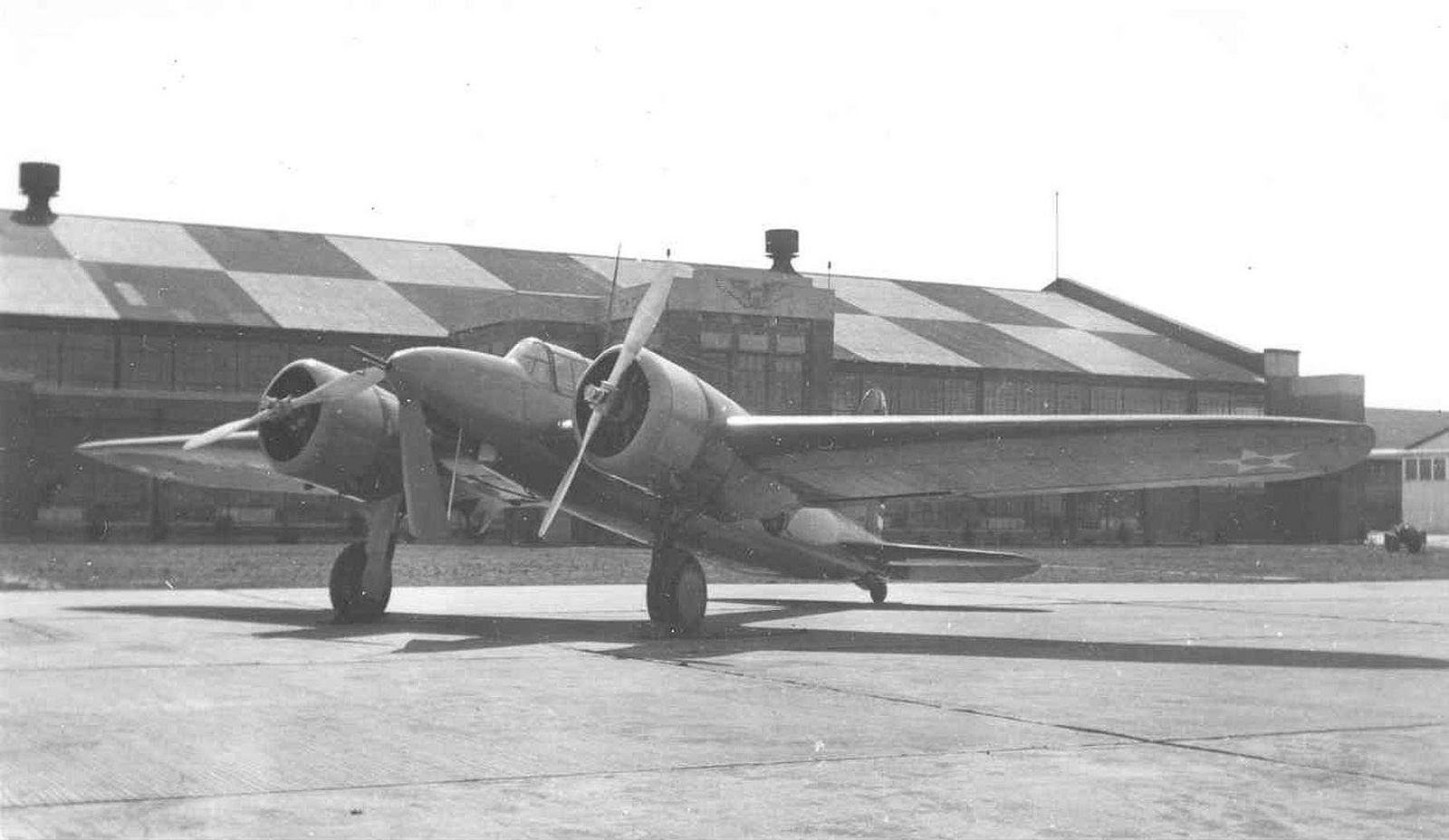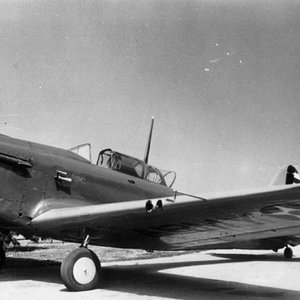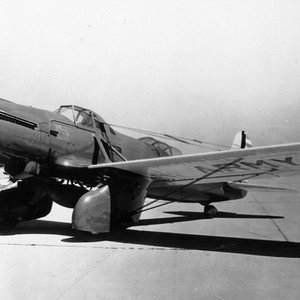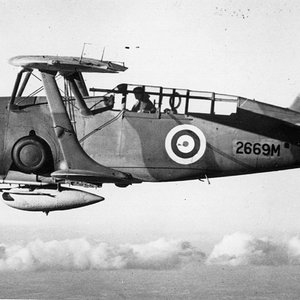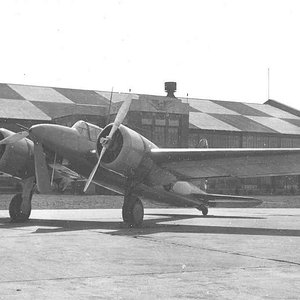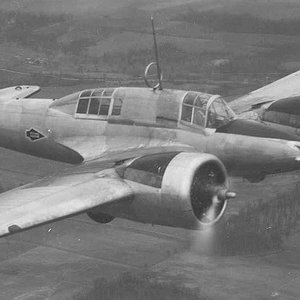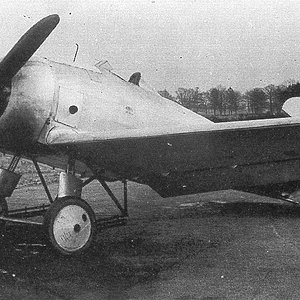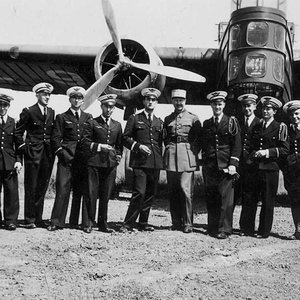Navigation
Install the app
How to install the app on iOS
Follow along with the video below to see how to install our site as a web app on your home screen.
Note: This feature may not be available in some browsers.
More options
You are using an out of date browser. It may not display this or other websites correctly.
You should upgrade or use an alternative browser.
You should upgrade or use an alternative browser.
Curtiss YA-14
3/4-front view of the Curtiss YA-14 with the cannon access door open. (U.S. Air Force photo) Originally built as an in-house venture as the Curtiss Model 76, powered by two experimental Wright XR-1510 radial engines, flight testing was sufficiently impressive that after the USAAC appraisal the Model 76 was returned to Curtiss and fitted with two 775 hp (578 kW) Wright R-1670-5 Cyclone engines with constant-speed propellers. This configuration was accepted by the Army with the designation XA-14.It had standard Army markings with the serial number 36-146.
The Model 76 was of all-metal construction with an oval section semimonocoque fuselage, described as "pencil slim". The XA-14 was extensively tested, at one stage being fitted with a 37 mm (1.46 in) nose cannon.
In July 1936 thirteen (serial numbers 37-52 to 37-64) developed versions, re-engined with two Wright R-1820-47 Cyclone twin-row radials, were ordered into production as the Y1A-18
In 1934 Curtiss initiated the Model 76 two-seat, twin-engined ground attack design for the Army which eventually became the XA-14. Flown initially as a company-owned aeroplane with civil registration NX-15314, it was fitted with the new and unproved Wright R-1670-5 twin-row engines under circular cowlings driving Curtiss two-blade two-position propellers. The construction was all metal, with fabric covering only on the movable control surfaces and on the wing aft of the front spar. All three undercarriage units retracted aft, leaving half of each wheel in the airstream.
Four 0.30 in (7.62 mm) machineguns were concentrated in the extremely short nose, and a single flexible 0.30 in (7.62 mm) machinegun was in the rear cockpit, which was situated inconveniently far aft of the forward cockpit. Bombs were carried in a fuselage bomb bay and chemical smoke tanks or additional bombs could be carried under the wings.
Following its first flight in September 1935 the Model 76 was tested by the Army at Wright Field and then returned to Curtiss. It underwent modifications that included a notable change of engine cowling shape and new constant-speed propellers, the aeroplane was accepted by the Army in December as the XA-14, Army s/n 36-146. The XA-14 had a short military life; after being used to test 37-mm cannon installations, it was scrapped in August 1938 with a total of only 158 flying hours.
On 23 July, 1936, the Army ordered thirteen Service test aircraft (s/n 37-52 to 32-64, c/n 12187 to 12199), designated Y1A-18 (Model 76A). The designation change resulted from the use of Wright R-1820-47 engines driving three-bladed propellers, while the bomb load was now carried in bays in each wing holding 200 lb (90 kg) each.
Deliveries began in July 1937 and were completed by October. The Y1A-18s served initially with the 8th Attack Squadron of the Third Attack Group but were transferred to the Third Bombardment Group for operational training as plain A-18s in 1940. The last A-18 was withdrawn from service in 1943.
While the new Shrikes, the Army's first twin-engined models in the ill-defined Attack Series, performed well, no production orders resulted. The Y1A-18 experience proved the advantages of the twin-engined type, however, and established the Air Corps requirements that resulted in the larger and heavier Douglas A-20 and A-26 designs.
An improved Model 76B with Pratt & Whitney R-1830 engines was proposed to the Army but not accepted and a similar Model 76B was advertized for export but found no customers.
Span:
Length:
Height:
Wing area:
Weight empty:
Weight loaded:
Max speed:
Cruise speed:
Climb:
Service ceiling:
Range:
XA-14
59 ft 6 in (18.13 m)
40 ft 6 in (12.34 m)
11 ft 0 in (3.35 m)
530 sq.ft (49.23 sq.m)
8,875 lb (4,026 kg)
11,656 lb (5,287 kg)
243 mph (391.06 kmh)
222 mph (357.26 kmh)
1,690 ft (515 m)/min
28,000 ft (8,534 m)
-
Y1A-18
59 ft 6 in (18.13 m)
41 ft 0 in (12.49 m)
11 ft 6 in (3.50 m)
530 sq.ft (49.23 sq.m)
9,580 lb (4,345 kg)
12,849 lb (5,828 kg)
247 mph (397.50 kmh)
217 mph (349.22 kmh)
-
25,000 ft (7,620 m)
651 mls (1,048 km)
3/4-front view of the Curtiss YA-14 with the cannon access door open. (U.S. Air Force photo) Originally built as an in-house venture as the Curtiss Model 76, powered by two experimental Wright XR-1510 radial engines, flight testing was sufficiently impressive that after the USAAC appraisal the Model 76 was returned to Curtiss and fitted with two 775 hp (578 kW) Wright R-1670-5 Cyclone engines with constant-speed propellers. This configuration was accepted by the Army with the designation XA-14.It had standard Army markings with the serial number 36-146.
The Model 76 was of all-metal construction with an oval section semimonocoque fuselage, described as "pencil slim". The XA-14 was extensively tested, at one stage being fitted with a 37 mm (1.46 in) nose cannon.
In July 1936 thirteen (serial numbers 37-52 to 37-64) developed versions, re-engined with two Wright R-1820-47 Cyclone twin-row radials, were ordered into production as the Y1A-18
In 1934 Curtiss initiated the Model 76 two-seat, twin-engined ground attack design for the Army which eventually became the XA-14. Flown initially as a company-owned aeroplane with civil registration NX-15314, it was fitted with the new and unproved Wright R-1670-5 twin-row engines under circular cowlings driving Curtiss two-blade two-position propellers. The construction was all metal, with fabric covering only on the movable control surfaces and on the wing aft of the front spar. All three undercarriage units retracted aft, leaving half of each wheel in the airstream.
Four 0.30 in (7.62 mm) machineguns were concentrated in the extremely short nose, and a single flexible 0.30 in (7.62 mm) machinegun was in the rear cockpit, which was situated inconveniently far aft of the forward cockpit. Bombs were carried in a fuselage bomb bay and chemical smoke tanks or additional bombs could be carried under the wings.
Following its first flight in September 1935 the Model 76 was tested by the Army at Wright Field and then returned to Curtiss. It underwent modifications that included a notable change of engine cowling shape and new constant-speed propellers, the aeroplane was accepted by the Army in December as the XA-14, Army s/n 36-146. The XA-14 had a short military life; after being used to test 37-mm cannon installations, it was scrapped in August 1938 with a total of only 158 flying hours.
On 23 July, 1936, the Army ordered thirteen Service test aircraft (s/n 37-52 to 32-64, c/n 12187 to 12199), designated Y1A-18 (Model 76A). The designation change resulted from the use of Wright R-1820-47 engines driving three-bladed propellers, while the bomb load was now carried in bays in each wing holding 200 lb (90 kg) each.
Deliveries began in July 1937 and were completed by October. The Y1A-18s served initially with the 8th Attack Squadron of the Third Attack Group but were transferred to the Third Bombardment Group for operational training as plain A-18s in 1940. The last A-18 was withdrawn from service in 1943.
While the new Shrikes, the Army's first twin-engined models in the ill-defined Attack Series, performed well, no production orders resulted. The Y1A-18 experience proved the advantages of the twin-engined type, however, and established the Air Corps requirements that resulted in the larger and heavier Douglas A-20 and A-26 designs.
An improved Model 76B with Pratt & Whitney R-1830 engines was proposed to the Army but not accepted and a similar Model 76B was advertized for export but found no customers.
Span:
Length:
Height:
Wing area:
Weight empty:
Weight loaded:
Max speed:
Cruise speed:
Climb:
Service ceiling:
Range:
XA-14
59 ft 6 in (18.13 m)
40 ft 6 in (12.34 m)
11 ft 0 in (3.35 m)
530 sq.ft (49.23 sq.m)
8,875 lb (4,026 kg)
11,656 lb (5,287 kg)
243 mph (391.06 kmh)
222 mph (357.26 kmh)
1,690 ft (515 m)/min
28,000 ft (8,534 m)
-
Y1A-18
59 ft 6 in (18.13 m)
41 ft 0 in (12.49 m)
11 ft 6 in (3.50 m)
530 sq.ft (49.23 sq.m)
9,580 lb (4,345 kg)
12,849 lb (5,828 kg)
247 mph (397.50 kmh)
217 mph (349.22 kmh)
-
25,000 ft (7,620 m)
651 mls (1,048 km)

